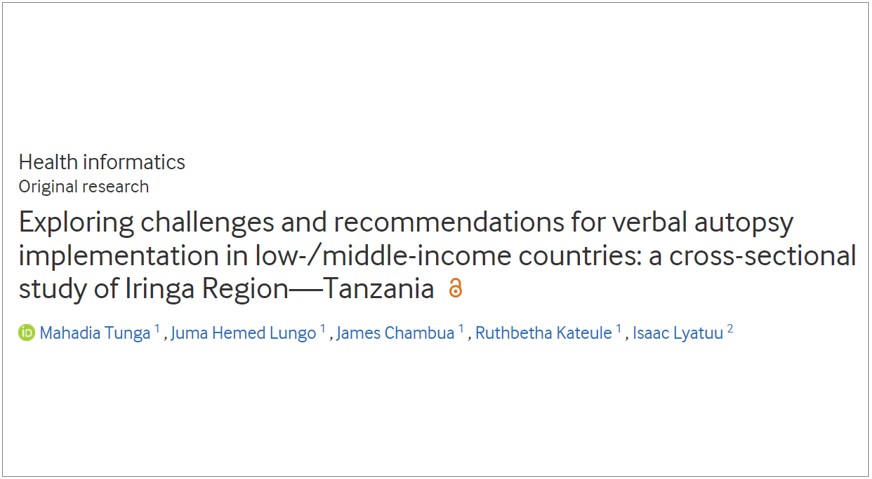
HEALTH STATS: Enhancing verbal autopsies for accurate cause-of-death information

Verbal autopsy – simply “VA” – is a vital tool in regions where cause-of-death information is rare, particularly low- and middle-income countries; according to findings from a study conducted by scientists from the Ifakara Health Institute and University of Dar es Salaam.
The study, published on the BMJ Open journal, outlines challenges and recommendations for implementing VA to support low- and middle-income countries in producing reliable mortality statistics for informed decisions on healthcare interventions.
VA’s history in Tanzania
Verbal autopsy - used to determine the cause of death through interviews with the deceased person's next of kin or caregivers to gather details on symptoms, medical history, and the circumstances leading to death - was developed in the 1950s, especially for regions where such data is lacking.
Countries with limited resources, like Tanzania, rely on VA tools to generate reliable cause-of-death statistics, underscoring the significance of VA adoption in low- and middle-income countries.
VA history in Tanzania dates back to 1992 when the Ministry of Health collected data on deaths through the Adult Morbidity and Mortality Project. Between 2002 and 2007, more VAs were conducted in collaboration with the Ifakara Health Institute, and later in 2009, Tanzania implemented a 5-year project called Sample Vital Events Registration and Verbal Autopsy (SAVVY) to improve the government's ability to collect and use data on deaths.
The SAVVY project aimed to assist in managing the national HIV/AIDS program by expanding the identification, reporting, and processing of death events.
VA implementation challenges
The study, conducted in Tanzania's Iringa region from June 2021 to September 2022, involving 41 participants, including community health workers and verbal autopsy coordinators, highlights challenges in the current VA system hindering effective implementation in the region. The challenges have also been previously raised in other studies and highlight systemic inefficiencies that continue to hinder the effective implementation of VA.
“Despite the extensive experience of VA implementation in Tanzania which dates back to the 1990s, there are still noticeable gaps, which present opportunities for enhancing current implementation methods.
“The study showed that a weak death notification system, lengthy VA questionnaire, poor data quality and inconsistent responses, poor coordination, poor financial mechanism, and lack of feedback loop were the main perceived VA implementation challenges that hindered its operationalization in Tanzania.”
Strategies for effective adoption of VA
To address these challenges, the scientists propose strategies focusing on four key aspects of the VA implementation process. These include legislative procedures for death notification, optimization of VA interview length, integration of VA into Civil Registration and Vital Statistics (CRVS) systems, and the establishment of consistent and timely feedback mechanisms to engage stakeholders effectively.
The scientists emphasize that “effective VA implementation demands thorough planning, stakeholder engagement, the upskilling of local experts, and fair compensation for interviewers” since data obtained from the VA have significant potential to fill the vital statistics gap in LMICs and coordinated efforts in the four areas can overcome systemic, technical, and behavioral challenges, facilitating the successful implementation of VA.
Scientists involved in the study
Mahadia Tunga, led the study from the University of Dar es Salaam College of Engineering and Technology, with contributions from colleagues Juma Hemed Lungo, James Chambua, and Ruthbetha Kateule, all affiliated with the same institution. Isaac Lyatuu from Ifakara Health Institute also played a role in contributing to the study.
Read the full publication here.
